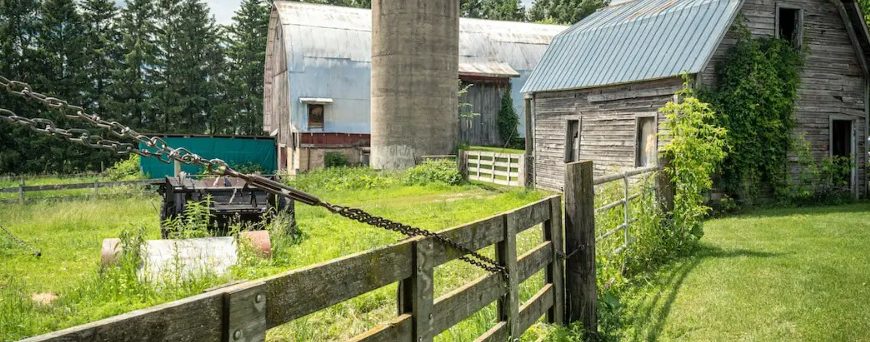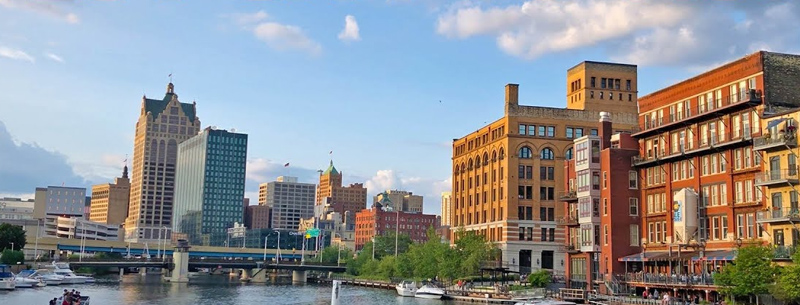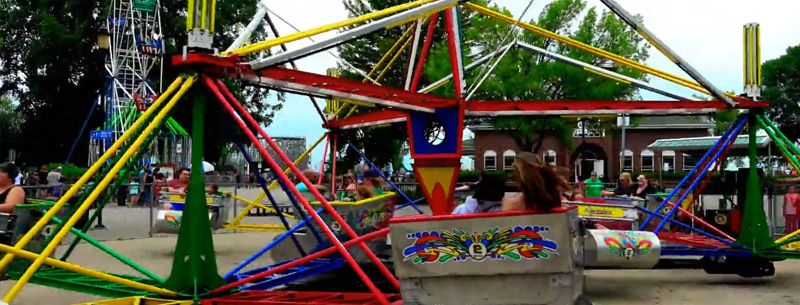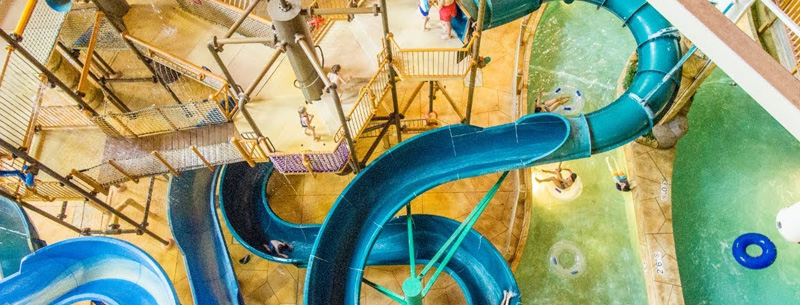2024 Wisconsin Visitors Guide
America’s Dairyland, as Wisconsin is suitably nicknamed, is particularly famous for two things: cheese and beer. The rolling plains filled with cattle are unquestionably responsible for earning the state its reputation and status as a leader in dairy production. Milwaukee is Wisconsin’s largest city, legendary for the tempting scent of malt seeping from its many breweries. Nearly one million people gather each year along the banks of Lake Michigan for Summerfest—a live music and entertainment festival.
The Wisconsin State Capitol in Madison, a stunning example of Roman Renaissance architecture, stands between Lake Mendota to the west and Lake Monona to the east. Green Bay is home to the NFL’s oldest team, the Green Bay Packers. A trip to this city during football season would not be complete without taking in a game at Lambeau Field or visiting the Green Bay Packers Hall of Fame. Although the wilderness of North Wisconsin is vast and sparsely populated (the largest city is Eau Claire), it does offer plenty of recreation for outdoor enthusiasts, as well as the National Freshwater Fishing Hall of Fame in Hayward.
Kenosha & Racine
Situated along the shoreline of Lake Michigan in the southeasternmost corner of Wisconsin, Kenosha-Racine’s atmosphere is closely tied to its lakeshore activities and historical attractions. Highlighting this character is the Lakeshore Trolley, a narrated tour that passes through the city of Kenosha’s three historic districts and the Lakeshore business district, which is laden with specialty shops and antique stores. During the summer, the region’s population swells, especially along the lakefront, where public beaches and parks account for 80 percent of the land. The rolling hills of Kenosha-Racine’s inland area support Wisconsin’s signature industry – dairy farms. And where there are dairy farms there is also fresh produce, best enjoyed right off the cart of a roadside stand.
Packer Country
While the name Packer Country refers specifically to the Green Bay Packers, the oldest football team in the NFL, it could just as easily be the term used to quantify the number of great attractions packed into this small space. For starters, the area’s proximity to water—Green Bay borders its north and Lake Michigan is situated in the east—creates an atmosphere rich in water recreation. History is another common thread woven throughout Packer Country. In Algoma, on Wisconsin’s northeastern shoreline, the streets of downtown are lined with restored historical buildings; heading south, Kewaunee’s affluence as an early lumber town is reflected in the early-1800s mansions preserved in the Marquette Historic District. Visitors to Mishicot can make a day of perusing for art by first visiting the Old School Gallery, where a large collection of original Norman Rockwell art makes its home, and then heading out to one of the town’s many antique stores. For beach lovers, Neshota Beach in Two Rivers is spread over 50 acres (hectares) and provides facilities for volleyball, basketball, and jet skiing.
Green Bay, WI Visitors Guide
A city synonymous with its sports team, Green Bay was established on the banks of Lake Michigan in 1634. It stands today as the oldest settlement in the Midwest. Green Bay and the surrounding area offer visitors a variety of attractions, shops, restaurants, and entertainment. Unquestionably, the premiere entertainment venue in Green Bay is football—Green Bay Packers pride runs thick through the city. Known as The Cheeseheads, Packers fans gather for home games at Lambeau Field, which is a spectacle in itself. Guided tours of the stadium are offered throughout the year. Sports fans also won’t want to miss the Green Bay Packers Hall of Fame.
Kenosha Visitors Guide
Municipal parks line most of the lakefront in Kenosha, Wisconsin’s southernmost port on Lake Michigan. As an important manufacturing center, Kenosha offers a wealth of shopping opportunities, perhaps the most attractive of which is the Original Outlet Mall, which offers some 100 stores selling brand-name goods. A number of boutiques and shops are also located downtown, an area that is easily navigated on Kenosha’s restored electric streetcar system. The city’s English heritage is celebrated at the Bristol Renaissance Faire, a replica of a 16th-century English village abuzz with entertainment, games, and crafts on weekends from early July to early September. Visitors enjoy year-round Greyhound racing and simulcast wagering across the United States at Kenosha’s Dairyland Greyhound Park, open seven days a week. For a day of family fun, visit Action Territory and play everything from paintball to mini-golf.
Madison, WI Visitors Guide
The area surrounding Wisconsin’s capital Madison offers much in the way of accommodations, attractions, and activities. Governor Nelson State Park is located in Waunakee, offering opportunities for water sports, hiking, picnicking, and more. The park is also open in the winter for snowshoeing and cross-country skiing. For a festive atmosphere, the Capital Brewing Company in Middleton features live outdoor music in a beer garden every Friday and Saturday from May to September. Nearby Janesville is home to a wide variety of lodging choices, as well as a number of shops and services for travelers. During the summer months, Janesville hosts the Rock Aqua Jays Waterski Shows, a carefully choreographed spectacle that features professional waterskiers. Janesville is also home to several golf courses that welcome golfers of all skill levels during the warmer months.
Madison uniquely couples small-town charm with big-city flavor. Downtown Madison is the only American city center built on an isthmus, between Lake Mendota and Lake Monona. The massive dome of the state capitol building dominates the skyline of this booming government, business, and education center. The State Street shopping district, an outdoor pedestrian mall, is filled with eclectic craft shops, boutiques, ethnic restaurants, outdoor cafes, and import shops. State Street is functional as well as recreational, by connecting Capitol Square to the University of Wisconsin Campus. This scenic, cosmopolitan city offers a range of opportunities to attract visitors from near and far.
Milwaukee Visitors Guide
Hugging the shores of Lake Michigan, Greater Milwaukee is a water lover’s paradise. In addition to providing recreation, Greater Milwaukee’s easy water access makes it an important shipping spot. The City of Milwaukee, made famous by its beer production, is Wisconsin’s largest city and economic powerhouse. Heading south of Milwaukee, Greenfield is best known for being home to the House of Harley Davidson, Milwaukee’s oldest and one of the world’s largest Harley dealerships. Cedarburg, just north of Milwaukee, offers a much slower pace. Guests should be sure to stop by the Cedar Creek Settlement, a historical village of shops, and the Cedar Creek Winery. Waukesha borders the western portion of the region and is home to Wisconsin’s oldest college, Carroll College, as well as Old World Wisconsin, a 576-acre (233-hectare) outdoor living museum with costumed interpreters, hands-on activities, and more.
Although German influence in Milwaukee has waned since the mid-1800s, when one-third of Milwaukee’s population was of German descent, German culture is still very much evident throughout the city. Milwaukee, the largest city in Wisconsin, is located in the southeastern portion of the state on the shore of Lake Michigan. Famous for beer, Milwaukee is home to the Miller Brewing Company and other smaller microbreweries around the city that offer tours. Summerfest, an annual music festival that takes place in downtown Milwaukee, draws together nearly one million attendees every July for music performances, comedy, international cuisine, and more. With its recent renovation, the Milwaukee Art Museum, which was founded by German artists in the late 1800s, holds an impressive collection of German expressionist paintings, Haitian art, modern art, and classics from the 19th and 20th centuries, to name a few.



